Exploring Efficiencies: Examining the Possibility of Decreasing the Size of the Briquettes Used as the Batch in the Electric Arc Furnace Dust Processing Line
Abstract
1. Introduction
2. Materials and Methods
- s is the compaction level,
- Hp is the initial height of the compacted material, and
- x is the displacement of the punch.
3. Results and Discussion
- ϑ is the compaction pressure characteristic,
- s is the compaction level, and
- w is the moisture content.
- μs is the coefficient of static friction,
- s is the compaction level, and
- w is the moisture content.
4. Conclusions
Funding
Acknowledgments
Conflicts of Interest
References
- Suetens, T.; Van Acker, K.; Blanpain, B.; Mishra, B.; Apelian, D. Moving Towards Better Recycling Options for electric arc furnace dust. J. Mater. 2014, 66, 1119–1121. [Google Scholar]
- Joulazadeh, M.; Joulazadeh, F. Slag; Value added steel industry byproducts. Arch. Metall. Mater. 2010, 55, 1137–1145. [Google Scholar] [CrossRef]
- Gara, P.; Zwolińska, B. Model of converter dusts and iron-bearing slurries management in briquetting. Metalurgija 2016, 55, 515–518. [Google Scholar]
- Jursová, S. Metallurgical waste and possibilities of its processing. In Proceedings of the 19th International Conference on Metallurgy and Materials: Metal 2010, Ostrava, Czech Republic, 18–20 May 2010; pp. 115–120. [Google Scholar]
- Rosler, G.; Pichler, C.; Antrekowitsch, J.; Wegscheider, S. “2sDR”: Process development of a sustainable way to recycle steel mill dusts in the 21st century. J. Min. Met. Mater. Soc. 2014, 66, 1721–1729. [Google Scholar] [CrossRef]
- Kashiwaya, Y.; Tsubone, A.; Ishii, K.; Sasamoto, H. Thermodynamic analysis on the dust generation from EAF for the recycling of dust. ISIJ Int. 2004, 44, 1774–1779. [Google Scholar] [CrossRef]
- Buzin, P.; Heck, N.; Vilela, A. EAF dust: An overview on the influences of physical, chemical and mineral features in its recycling and waste incorporation routes. J. Mater. Res. Technol. 2016, 6, 194–202. [Google Scholar] [CrossRef]
- Shawabkeh, R.A. Hydrometallurgical extraction of zinc from Jordanian electric arc furnace dust. Hydrometallurgy 2010, 104, 61–65. [Google Scholar] [CrossRef]
- Besta, P.; Samolejová, A.; Janovská, K.; Lenort, R.; Haverland, J. The effect of harmful elements in production of iron in relation to input and output material balance. Metalurgija 2012, 51, 325–328. [Google Scholar]
- Gawenda, T.; Saramak, D. Assessment of the process efficiency for metallurgical zinc waste screening in vibrating screen. J. Pol. Miner. Eng. Soc. 2018, 19, 189–194. (In Polish) [Google Scholar] [CrossRef]
- Guezennec, A.-G.; Huber, J.-C.; Patisson, F.; Sessiecq, P.; Birat, J.-P.; Ablitzer, D. Dust formation in Electric Arc Furnace: Birth of the particles. Powder Technol. 2005, 157, 2–11. [Google Scholar] [CrossRef]
- Havlık, T.; Vidor, E.; Souza, B.; Bernardes, A.M.; Homrich Schneider, I.A.; Miskufova, A. Hydrometallurgical processing of carbon steel EAF dust. J. Hazard. Mater. 2006, 135, 311–318. [Google Scholar] [CrossRef] [PubMed]
- Kumar, D.S.; Sah, R.; Sekhar, V.R.; Vishwanath, S.C. Development and use of mill scale briquettes in BOF. Ironmak. Steelmak. 2017, 44, 134–139. [Google Scholar] [CrossRef]
- El-Hussiny, N.A.; Shalabi, M.E.H. A self-reduced intermediate product from iron and steel plants waste materials using a briquetting process. Powder Technol. 2011, 205, 217–223. [Google Scholar] [CrossRef]
- Lopez, F.A.; Lopez-Delgado, A. Enhancement of electric arc furnace dust by recycling to electric arc furnace. J. Environ. Eng. 2002, 128, 1169–1174. [Google Scholar] [CrossRef]
- Cholewiński, W.; Kenig, R.; Pasierb, J.; Woźniacki, Z.; Hryniewicz, M.; Bembenek, M.; Gara, P. Method for the Recovery and Separation of Zinc Oxide in the Pyrometallurgical Process of Agglomeration of Fine Grained Waste Materials, Preferably Metallurgical Discards. Polish Patent PL 225,632 B1, 23 September 2016. (In Polish). [Google Scholar]
- Magdziarz, A.; Kuźnia, M.; Bembenek, M.; Gara, P.; Hryniewicz, M. Briquetting of EAF dust for its utilisation in metallurgical processes. Chem. Process Eng. 2015, 36, 263–271. [Google Scholar] [CrossRef]
- Babanin, V.I.; Eremin, A.Y. Briquetting fine-grained materials in ferroalloys production: Practical experience and future prospects. Metallurgist 2006, 50, 241–247. [Google Scholar] [CrossRef]
- Hryniewicz, M.; Janewicz, A. Research into the possibility of basic oxygen furnace consolidation in a roll press. Pol. J. Environ. Stud. 2008, 17, 235–239. [Google Scholar]
- Lemos, L.; Seabra da Rocha, S.H.F.; Andrade de Castro, L.F. Reduction disintegration mechanism of cold briquettes from blast furnace dust and sludge. J. Mater. Sci. Technol. 2015, 4, 278–282. [Google Scholar] [CrossRef]
- Mihok, L.; Baricova, D. Recycling of oxygen converter flue dust into oxygen converter charge. Metalurgija 2003, 42, 271–275. [Google Scholar]
- Bembenek, M. Research and prospects for new areas of using roller presses. Przem. Chem. 2017, 9, 1845–1847. (In Polish) [Google Scholar] [CrossRef]
- Drzymła, Z. Research into the briquetting process for improved design of briquetting machines. Mater. Des. 1994, 15, 33–40. [Google Scholar] [CrossRef]
- Tomporowski, A.; Flizikowski, J.; Kruszelnicka, W. A new concept of roller-plate mill. Przem. Chem. 2017, 96, 1750–1755. (In Polish) [Google Scholar] [CrossRef]
- Yehia, K.A. Estimation of roll press design parameters based on the assessment of a particular nip region. Powder Technol. 2007, 177, 148–153. [Google Scholar] [CrossRef]
- Baiul, K.V. Synthesis of Roller Press Rational Design for Composite Solid Fuel Production. Probl. Reg. Energetics 2019, 2, 103–116. [Google Scholar] [CrossRef]
- Hryniewicz, M.; Bembenek, M.; Janewicz, A.; Kosturkiewicz, B. Agglomeration of fine-grained materials in roll presses with asymmetrical compaction unit. Przem. Chem. 2015, 94, 2223–2226. (In Polish) [Google Scholar] [CrossRef]
- Hryniewicz, M. Method of Selection of Roll Presses and Elaboration of Design Criteria for Their Modernization or Construction; Wydawnictwa AGH: Kraków, Poland, 1997. (In Polish) [Google Scholar]
- Hryniewicz, M.; Janewicz, A.; Kosturkiewicz, B. Research of external friction in briquetting process of copper concentrates. Inżynieria I Apar. Chem. 2006, 45, 68–69. (In Polish) [Google Scholar]
- Bembenek, M. The issue of selection: Shape and volume of briquettes agglomerated in a roller press. J. KONES Powertrain Transp. 2017, 24, 31–38. [Google Scholar] [CrossRef]
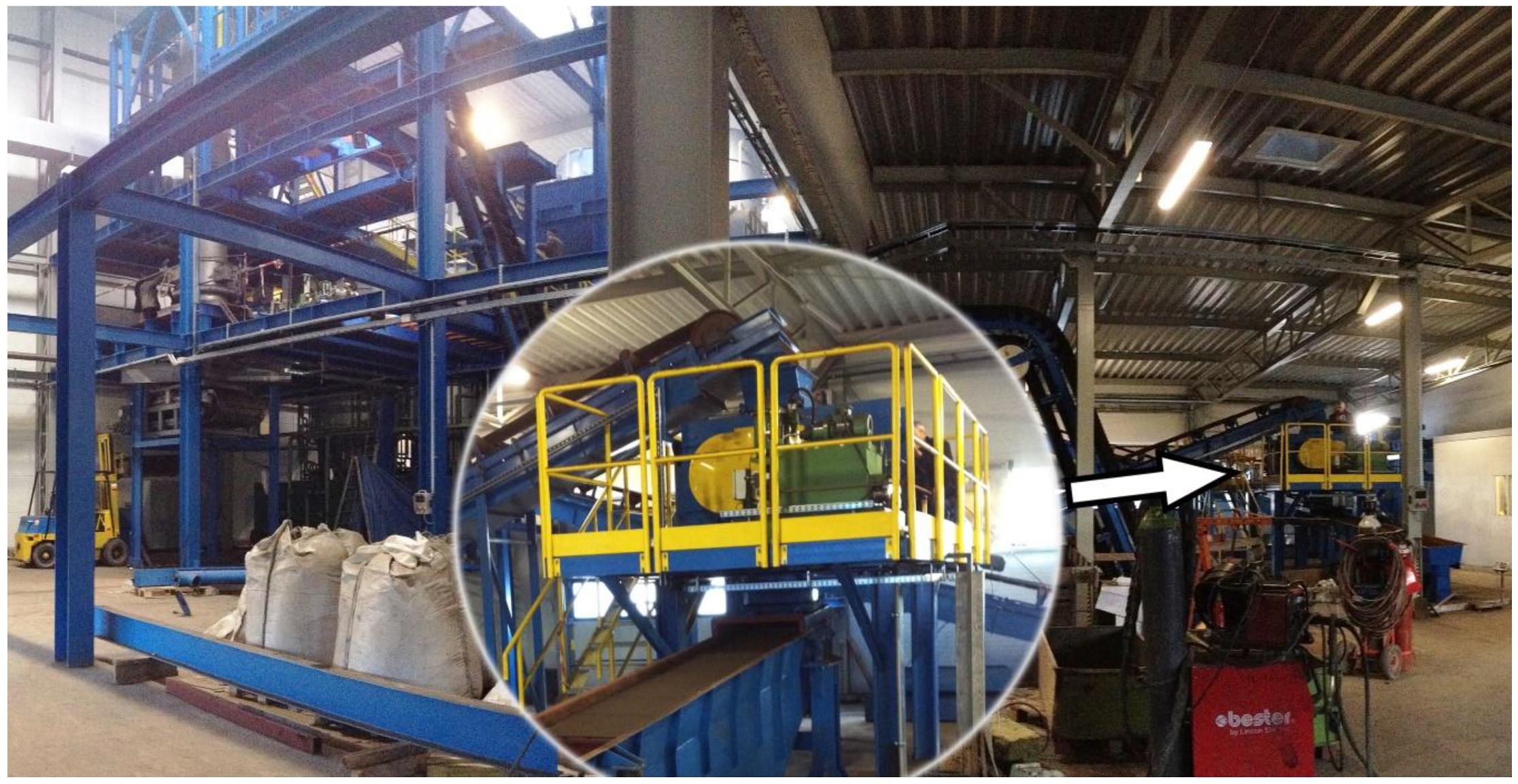
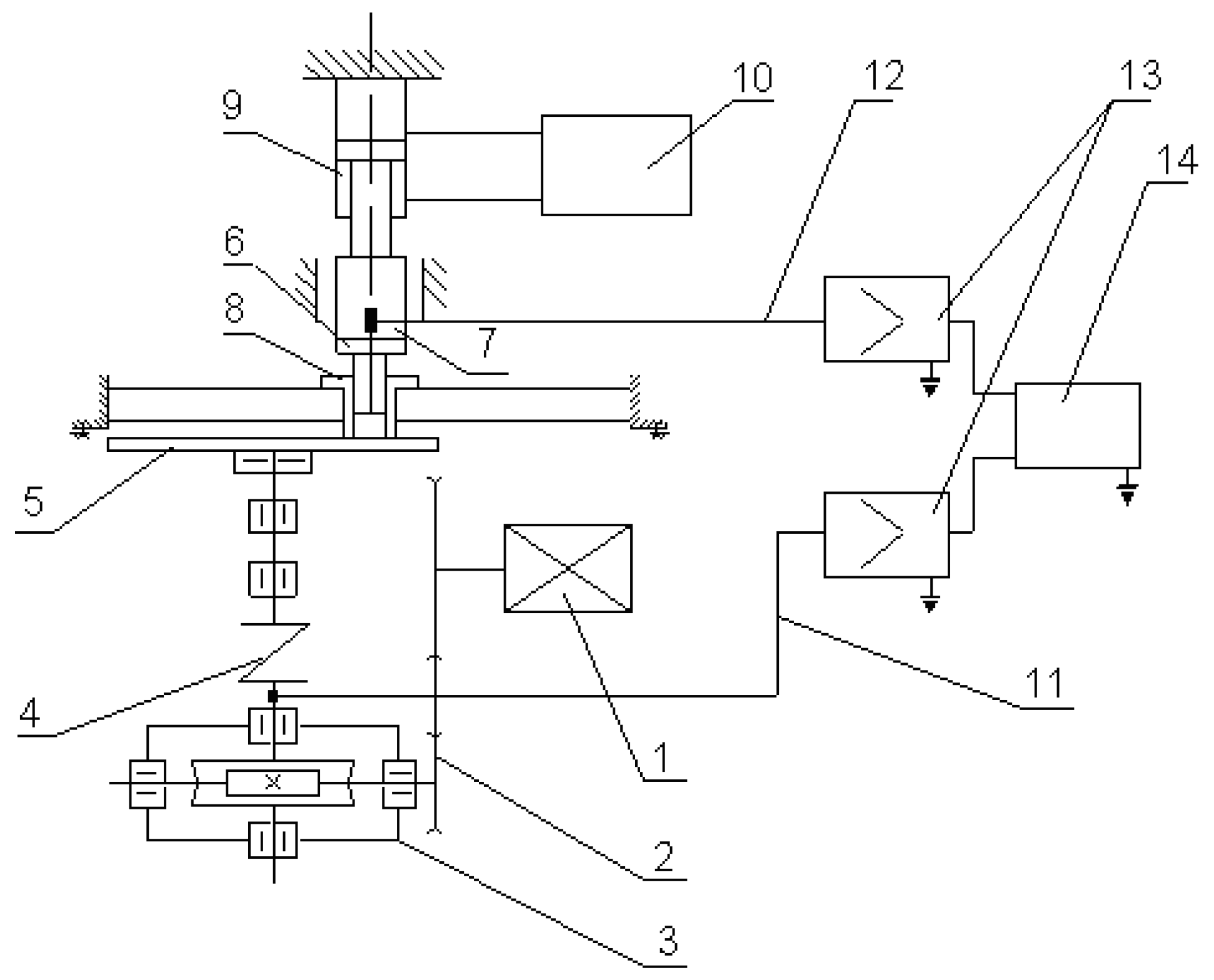
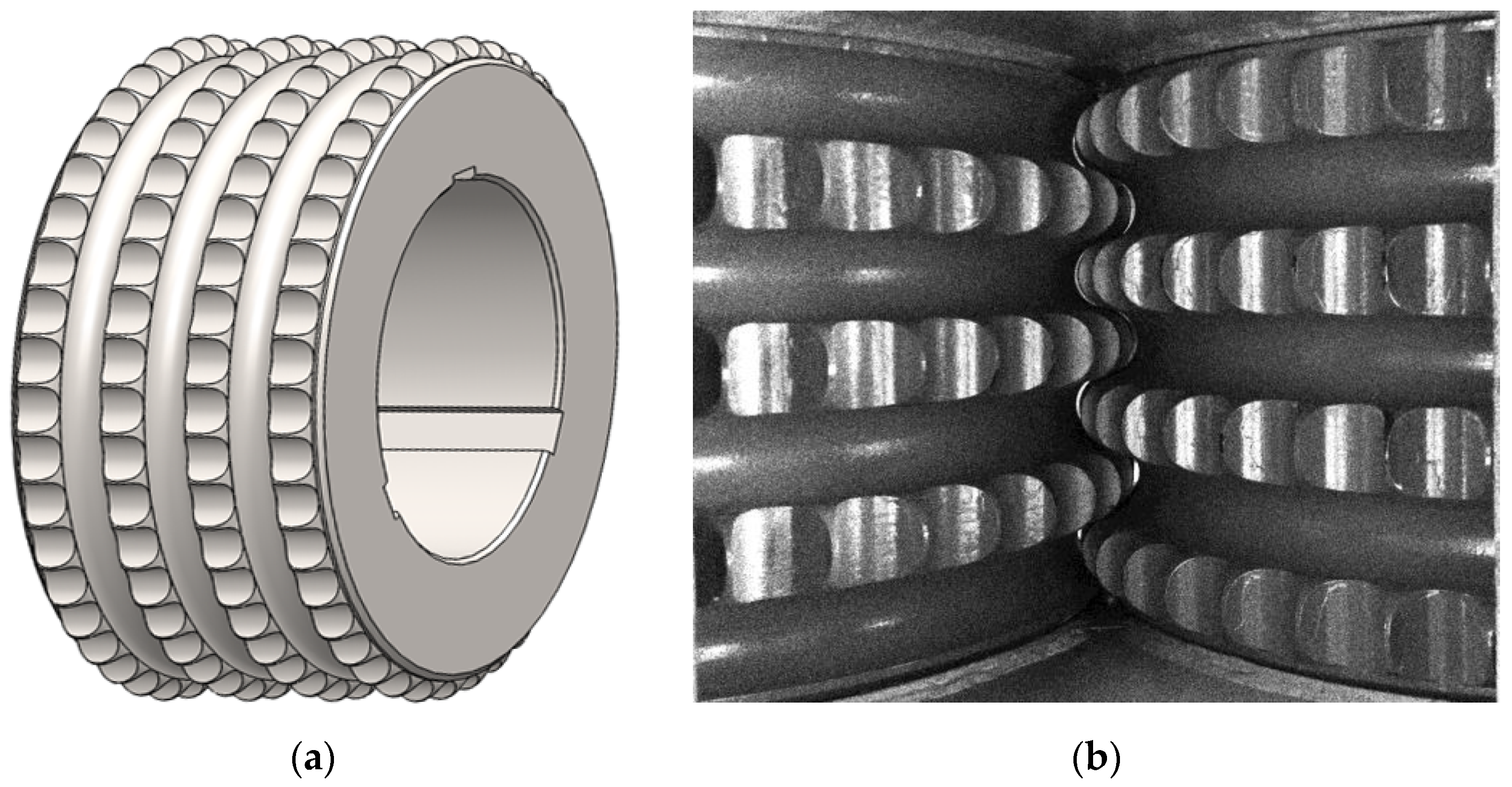
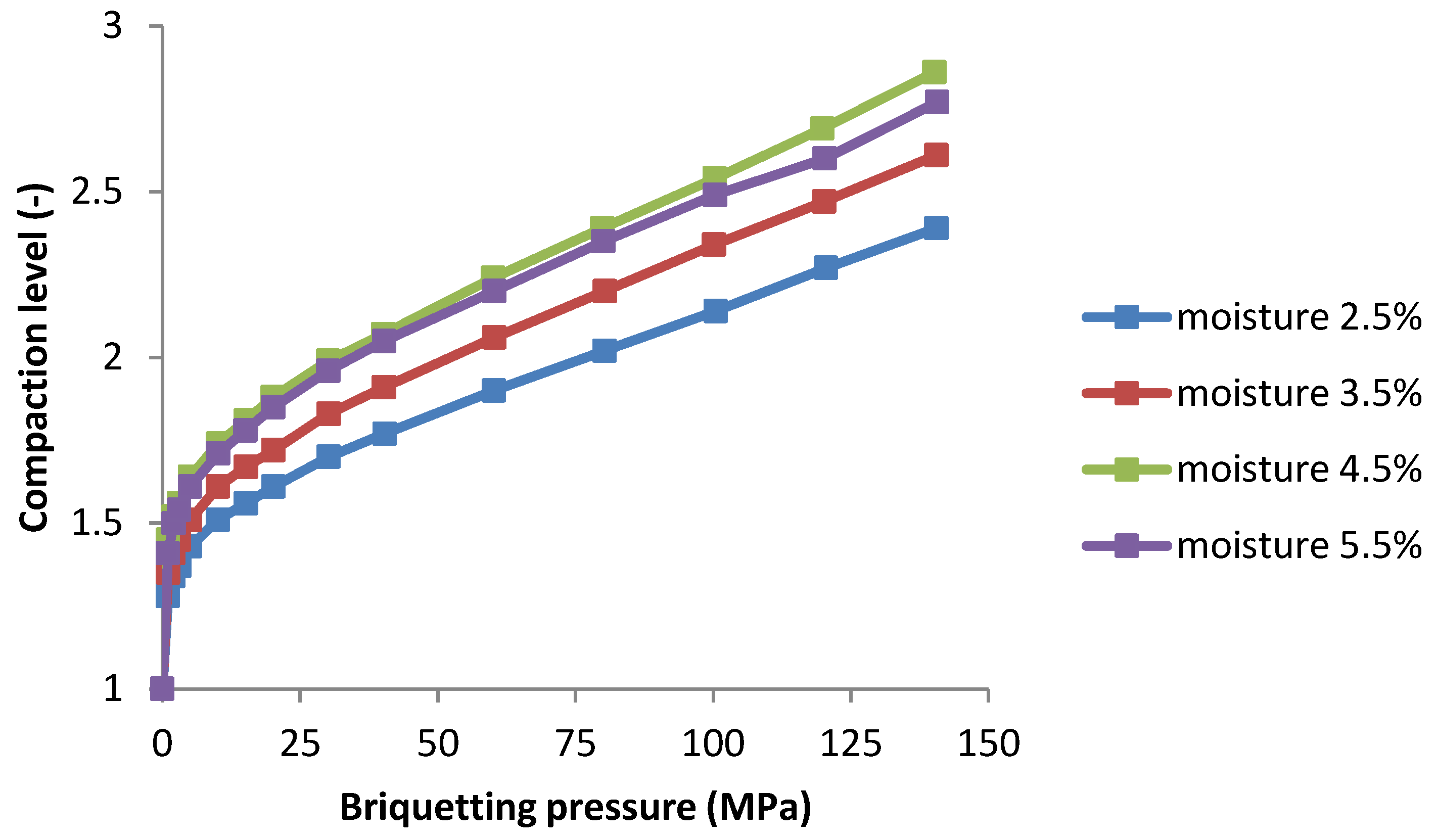
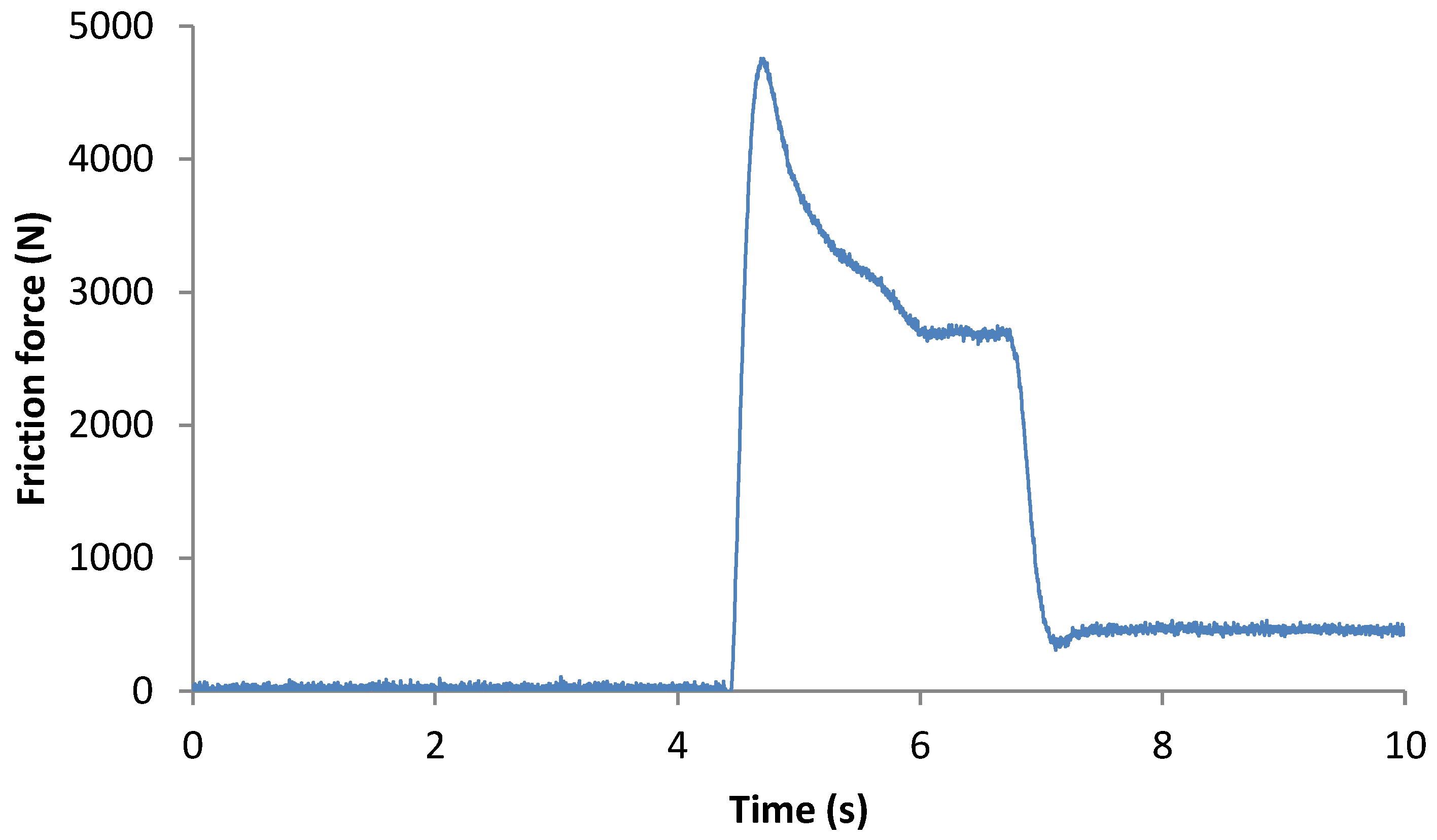
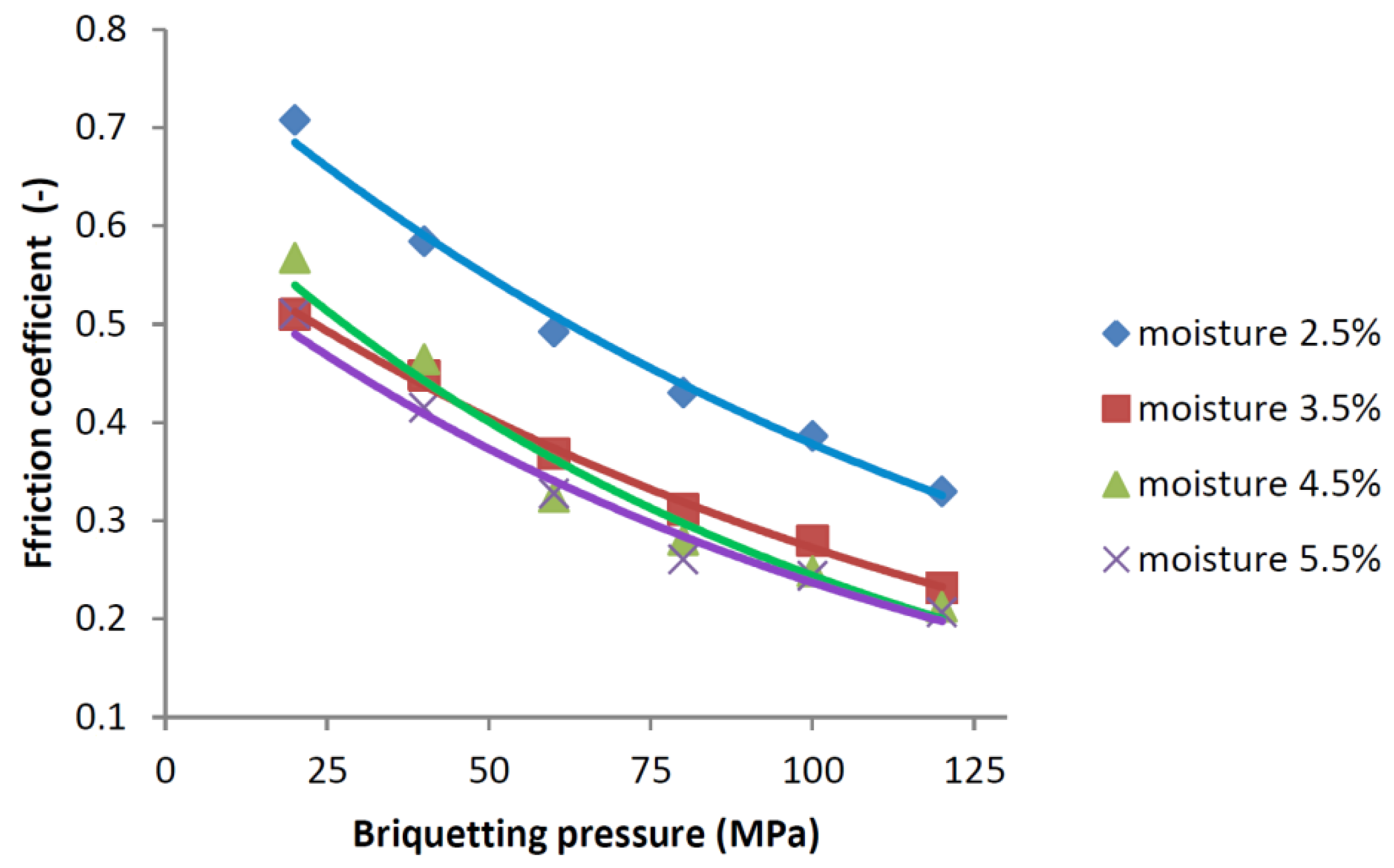
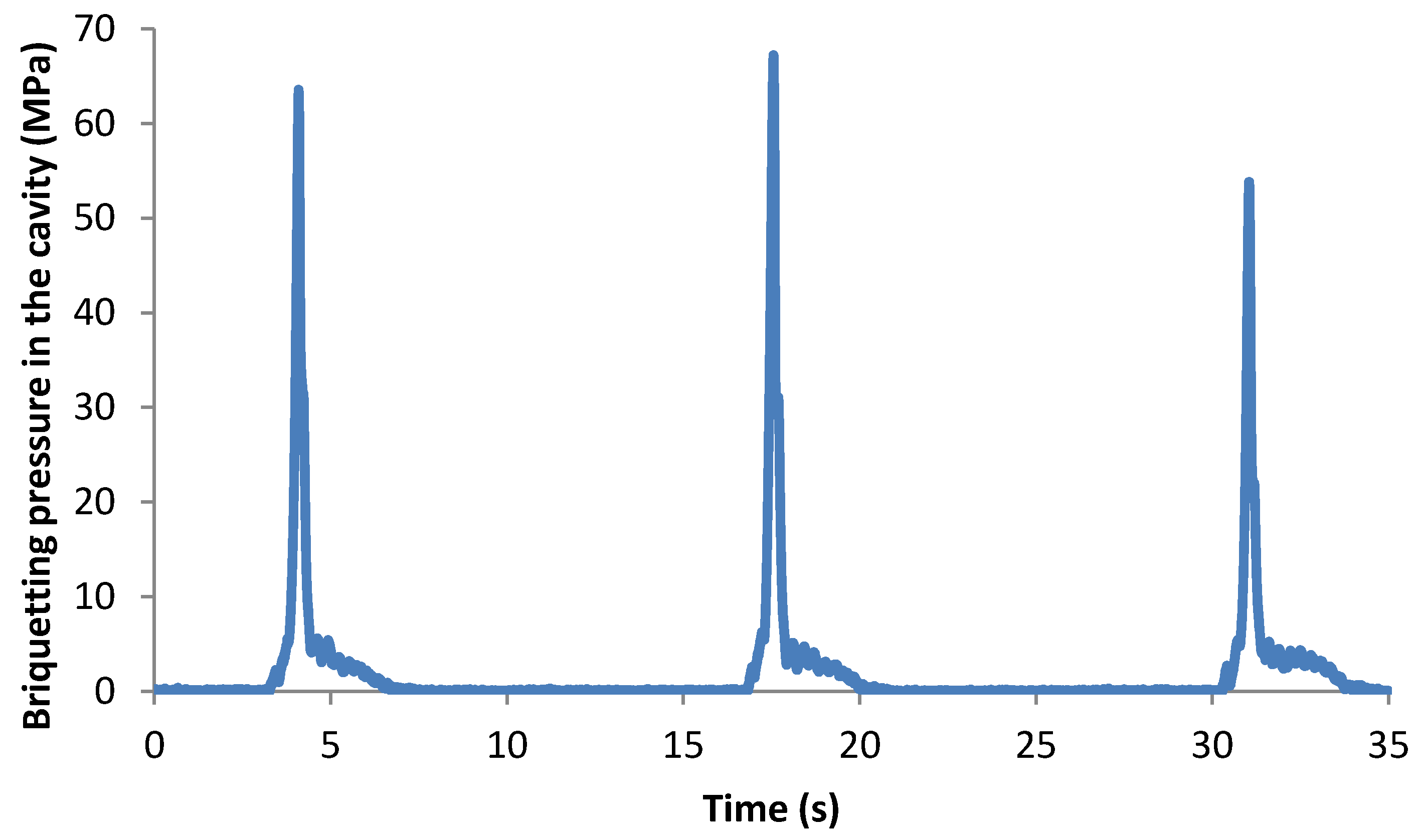
| Briquette Volume (cm3) | Briquette Size (mm) | Number of Rows | Number of Cavities in the Row | Total Number of Cavities |
|---|---|---|---|---|
| 13.0 | 37 × 37 × 17 | 7 | 42 | 294 |
| 10.5 | 34 × 34 × 16 | 7 | 45 | 315 |
| 8.5 | 32 × 32 × 15 | 8 | 48 | 384 |
| 6.5 | 30 × 29 × 14 | 9 | 52 | 468 |
| Moisture Content of EAFD Mixture (%) | Maximum Measured Briquetting Pressure (MPa) | Average Maximum Measured Unit Pressure (MPa) | Grip Angle (°) |
|---|---|---|---|
| 3.0 | 73.1, 78.3, 67.9 | 73.1 | 4.82 |
| 5.0 | 63.4, 66.6, 53.0 | 61.0 | 5.29 |
| 6.8 | 51.9, 52.4, 39.6 | 48.0 | 5.36 |
| Briquette Volume | EAFD Mixture Moisture (%) | Gap Between Rollers (mm) | Maximum Pressure (MPa) | Maximum Force (kN) | Maximum Torque (Nm) | Maximum Power Consumption (kW) * |
|---|---|---|---|---|---|---|
| 13.0 | 3.0 | 2 | 46.9 | 226.7 | 14785 | 19.7 |
| 13.0 | 2.0 | 2 | 68.4 | 330.4 | 21506 | 28.7 |
| 13.0 | 3.0 | 1 | 57.1 | 275.7 | 17807 | 23.7 |
| 13.0 | 2.0 | 1 | 83.2 | 401.6 | 25891 | 34.5 |
| 13.0 | 4.5 | 2 | 32.3 | 155.9 | 10195 | 13.6 |
| 13.0 | 6.3 | 2 | 23.7 | 114.6 | 7514 | 10.0 |
| 10.5 | 3.0 | 2 | 60.4 | 292.9 | 18869 | 25.2 |
| 10.5 | 2.0 | 2 | 88.0 | 425.7 | 27430 | 36.6 |
| 10.5 | 3.0 | 1 | 76.7 | 370.7 | 23631 | 31.5 |
| 10.5 | 2.0 | 1 | 111.7 | 539.6 | 34331 | 45.8 |
| 8.5 | 3.0 | 2 | 61.9 | 299.3 | 19301 | 25.7 |
| 8.5 | 2.0 | 2 | 90.1 | 435.8 | 28057 | 37.4 |
| 8.5 | 3.0 | 1 | 78.9 | 381.2 | 24268 | 32.4 |
| 8.5 | 2.0 | 1 | 114.8 | 554.8 | 35254 | 47.0 |
| 6.5 | 3.0 | 2 | 70.2 | 339.8 | 21793 | 29.1 |
| 6.5 | 2.0 | 2 | 102.1 | 494.7 | 31669 | 42.2 |
| 6.5 | 3.0 | 1 | 91.7 | 443.3 | 28014 | 37.4 |
| 6.5 | 2.0 | 1 | 133.4 | 644.9 | 40680 | 54.2 |
© 2020 by the author. Licensee MDPI, Basel, Switzerland. This article is an open access article distributed under the terms and conditions of the Creative Commons Attribution (CC BY) license (http://creativecommons.org/licenses/by/4.0/).
Share and Cite
Bembenek, M. Exploring Efficiencies: Examining the Possibility of Decreasing the Size of the Briquettes Used as the Batch in the Electric Arc Furnace Dust Processing Line. Sustainability 2020, 12, 6393. https://doi.org/10.3390/su12166393
Bembenek M. Exploring Efficiencies: Examining the Possibility of Decreasing the Size of the Briquettes Used as the Batch in the Electric Arc Furnace Dust Processing Line. Sustainability. 2020; 12(16):6393. https://doi.org/10.3390/su12166393
Chicago/Turabian StyleBembenek, Michał. 2020. "Exploring Efficiencies: Examining the Possibility of Decreasing the Size of the Briquettes Used as the Batch in the Electric Arc Furnace Dust Processing Line" Sustainability 12, no. 16: 6393. https://doi.org/10.3390/su12166393
APA StyleBembenek, M. (2020). Exploring Efficiencies: Examining the Possibility of Decreasing the Size of the Briquettes Used as the Batch in the Electric Arc Furnace Dust Processing Line. Sustainability, 12(16), 6393. https://doi.org/10.3390/su12166393





